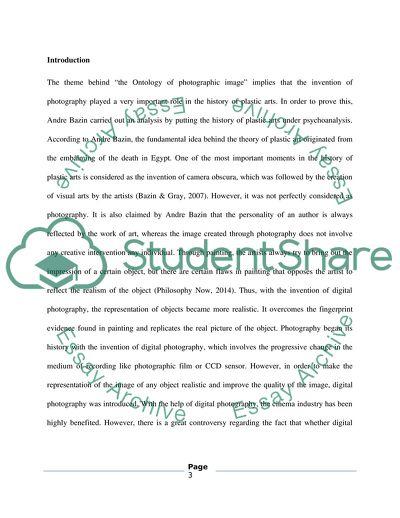Cite this document
(The Ontology of Photographic Image Essay Example | Topics and Well Written Essays - 2000 words, n.d.)
The Ontology of Photographic Image Essay Example | Topics and Well Written Essays - 2000 words. https://studentshare.org/visual-arts-film-studies/1854725-1-in-his-essay-the-ontology-of-the-photographic-image-andr-bazin-argues-that-photography-marks-both-an-extension-of-earlier-forms-of-image-making-and-a-significant-departure-in-the-way-its-images-are-created-through-automatic-means-to-what-ext
The Ontology of Photographic Image Essay Example | Topics and Well Written Essays - 2000 words. https://studentshare.org/visual-arts-film-studies/1854725-1-in-his-essay-the-ontology-of-the-photographic-image-andr-bazin-argues-that-photography-marks-both-an-extension-of-earlier-forms-of-image-making-and-a-significant-departure-in-the-way-its-images-are-created-through-automatic-means-to-what-ext
(The Ontology of Photographic Image Essay Example | Topics and Well Written Essays - 2000 Words)
The Ontology of Photographic Image Essay Example | Topics and Well Written Essays - 2000 Words. https://studentshare.org/visual-arts-film-studies/1854725-1-in-his-essay-the-ontology-of-the-photographic-image-andr-bazin-argues-that-photography-marks-both-an-extension-of-earlier-forms-of-image-making-and-a-significant-departure-in-the-way-its-images-are-created-through-automatic-means-to-what-ext.
The Ontology of Photographic Image Essay Example | Topics and Well Written Essays - 2000 Words. https://studentshare.org/visual-arts-film-studies/1854725-1-in-his-essay-the-ontology-of-the-photographic-image-andr-bazin-argues-that-photography-marks-both-an-extension-of-earlier-forms-of-image-making-and-a-significant-departure-in-the-way-its-images-are-created-through-automatic-means-to-what-ext.
“The Ontology of Photographic Image Essay Example | Topics and Well Written Essays - 2000 Words”. https://studentshare.org/visual-arts-film-studies/1854725-1-in-his-essay-the-ontology-of-the-photographic-image-andr-bazin-argues-that-photography-marks-both-an-extension-of-earlier-forms-of-image-making-and-a-significant-departure-in-the-way-its-images-are-created-through-automatic-means-to-what-ext.


